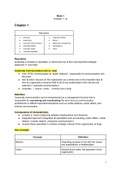Week 1
(Chapter 1, 4)
Chapter 1
Key terms
● Advocacy ● Integration Market
● Authenticity ● Mission
● Corporate Communication ● Stakeholder engagement
● Corporate identity ● Transparency
● Corporate image ● Vision
● Corporate reputation
Reputation
protecting a company’s reputation is critical and one of the most important strategic
objectives (= core task)
Corporate Communication (old vs. new)
● Until 1970s: communicator as “public relations”, responsible for communication with
the press
● new function: focuses on the organization as a whole and on the important task of
how an organization presents itself to all its key stakeholders both internal and
external (= corporate communication)
● corporate → corpus = body → forming into a body
Definition
Corporate communication can be characterized as a management function that is
responsible for overseeing and coordinating the work done by communication
practitioners in different specialist disciplines such as media relations, public affairs, and
internal communication.
Consequence of characteristics
● complex in nature (balancing between headquarters and divisions)
● integrated approach (integrates all specialties such as branding, public affairs, media
relation, investor relation, employee communication)
● crosses these specialties to achieve strategic interest of the organization at large
Key concepts
Concept Definition
Mission Overriding purpose in line with the values
and expectations of stakeholders
Vision Desired future state: the aspiration of the
organization
1
, Corporate objectives Statement of overall aims in line with overall
purpose
Strategy The ways in which the corporate objectives
are to be achieved and put into effect.
Corporate identity The profile and values communicated by an
organization
Corporate image The immediate set of associations of an
individual in response to one or more
messages from/about a particular
organization at a single point in time.
Corporate reputation An individual’s collective representation of
past images of an organization (induced
through either communication or past
experiences) established over time
Stakeholder Any group or individual who can affect or is
affected by the achievement of the
organization’s objectives.
Market A defined group for whom a product is or
may be in demand (and for whom an
organization creates and maintains
products and services)
Communication The tactics and media that are used to
communicate with internal and external
groups
Integration The act of coordinating all communication
so that the CI is effective and consistently
communicated to internal and external
groups.
Trends in Corporate Communication
Positioning:
Until the early 2000s organizations became primarly concerned with ideas such as
“corporate identity”, “corporate reputation”, and “corporate branding”, which emphasize the
importance of positioning (driver for more integrated communication). The assumption is that
2
, corporate communicators can strategically plan and design their messages in order to, in
effect, “take up” a reputational “position” in the minds of stakeholders.
Stakeholder engagement:
● replacing traditional one way structure with dynamic process in which leaders talk
with employees and not just to them
● individual stakeholders can share experiences, opinions and ideas about
organization and organize for action at scale
● new media technologies are the enabling factor in this process
In this view, the current state of corporate communication is one of gradual change, where
there is a change in terms of how organizations communicate with stakeholders, but also
continuity in that the old principles of strategic messaging and reputation management still
apply.
Communication was, up until the 1970s, largely used in a tactical support role for other
functions such as finance and marketing in the organization, where its role was to announce
corporate decisions, publicize corporate events or promote products and services. The
1980s, as mentioned, saw a real shift in that communication became used in a more
strategic sense to realize the organization’s objectives and to build reputational capital with
stakeholders upon whom the organization depends for its continued success and survival.
The ‘positioning’ paradigm that emerged at that time is, however, gradually evolving into a
new era of ‘stakeholder engagement’ which brings with it new points of emphasis around
interactivity, authenticity, transparency and advocacy.
Example: Apple (page 13)
Chapter 4
Contemporary organizations increasingly realize that they need to communicate with their
stakeholders to develop and protect their reputations.
Key terms
● Corporate social ● neo-classical economic
responsibility theory
● dialogue strategy ● persuasive strategy
● economic/market stakes ● power-interest matrix
● equity stakes ● socio-economic theory
● influencer stake ● stakeholder
● informational strategy ● stakeholder management
● legitimacy ● stakeholder salience
neo-classical economic theory
The purpose of organizations is to make profits in their accountability to themselves and to
shareholders, and that only by doing so can business contribute to wealth for itself as well as
society at large
3






